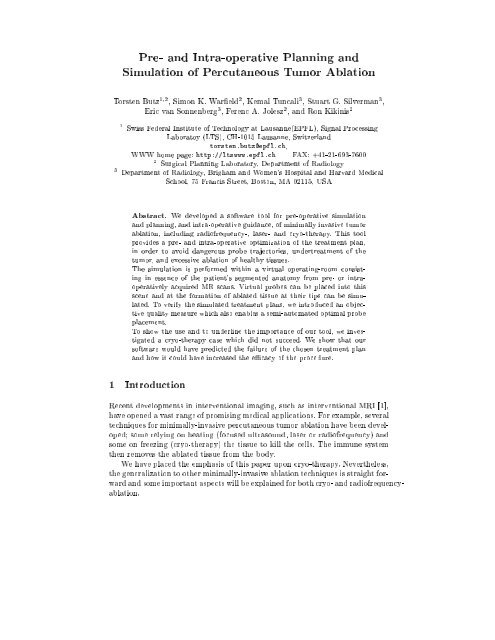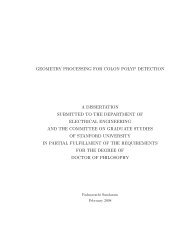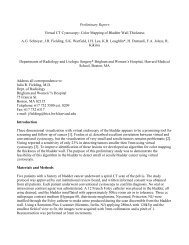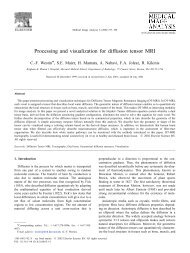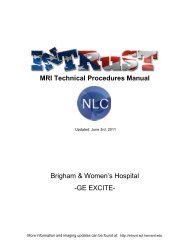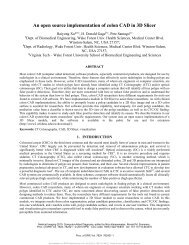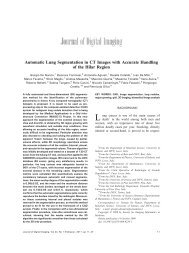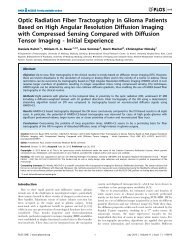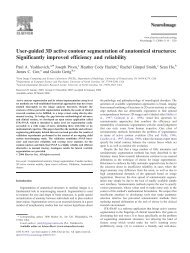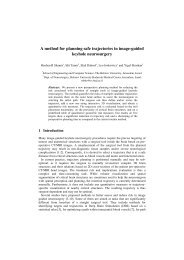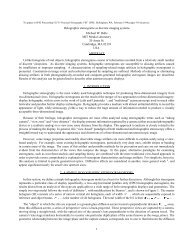Pre - Surgical Planning Laboratory
Pre - Surgical Planning Laboratory
Pre - Surgical Planning Laboratory
- No tags were found...
You also want an ePaper? Increase the reach of your titles
YUMPU automatically turns print PDFs into web optimized ePapers that Google loves.
<strong>Pre</strong>- and Intra-operative <strong>Planning</strong> andSimulation of Percutaneous Tumor AblationTorsten Butz 12 , Simon K. Wareld 2 , Kemal Tuncali 3 , Stuart G. Silverman 3 ,Eric van Sonnenberg 3 ,Ferenc A. Jolesz 2 , and Ron Kikinis 21 Swiss Federal Institute of Technology at Lausanne(EPFL), Signal ProcessingLaboratoy (LTS), CH-1015 Lausanne, Switzerlandtorsten.butz@epfl.ch,WWW home page: http://ltswww.epfl.ch FAX: +41-21-693-76002 <strong>Surgical</strong> <strong>Planning</strong> <strong>Laboratory</strong>, Department of Radiology3 Department of Radiology, Brigham and Women's Hospital and Harvard MedicalSchool, 75 Francis Street, Boston, MA 02115, USAAbstract. We developed a software tool for pre-operative simulationand planning, and intra-operative guidance, of minimally invasive tumorablation, including radiofrequency-, laser- and cryo-therapy. This toolprovides a pre- and intra-operative optimization of the treatment plan,in order to avoid dangerous probe trajectories, undertreatment ofthetumor, and excessive ablation of healthy tissues.The simulation is performed within a virtual operating-room consistingin essence of the patient's segmented anatomy from pre- or intraoperativelyacquired MR scans. Virtual probes can be placed into thisscene and at the formation of ablated tissue at their tips can be simulated.To verify the simulated treatment plans, we introduced an objectivequality measure which also enables a semi-automated optimal probeplacement.To show the use and to underline the importance of our tool, we investigateda cryo-therapy case which did not succeed. We show that oursoftware would have predicted the failure of the chosen treatment planand how it could have increased the ecacy of the procedure.1 IntroductionRecent developments in interventional imaging, such asinterventional MRI [1],haveopenedavast range of promising medical applications. For example, severaltechniques for minimally-invasive percutaneous tumor ablation have been developedsome relying on heating (focused ultrasound, laser or radiofrequency) andsome on freezing (cryo-therapy) the tissue to kill the cells. The immune systemthen removes the ablated tissue from the body.We have placed the emphasis of this paper upon cryo-therapy. Nevertheless,the generalization to other minimally-invasive ablation techniques is straightforwardand some important aspects will be explained for both cryo- and radiofrequencyablation.
1.1 Limitations of Conventional <strong>Planning</strong>In tumor ablation, the radiologists try to cover the arbitrarily shaped tumorwith a given number of discrete objects of approximately known shape, representingthe critical ablation temperatures for killing cancerous cells. In cryotherapy,the temperatures within the tumor should nowhere be above, and forthermo-ablation below, this bound. For interstitial tumor ablation, the cooling,respectively heating source is located on the tip of a needle-like probe which ispercutaneously inserted through a catheter into the tumor.The safety and success of a treatment plan depends mainly on the threefollowing points:1. Choosing secure probe trajectories.2. Ablating all the cancerous cells.3. Killing as little of the surrounding healthy tissue as possible.Unfortunately it is very dicult to nd the treatment plan that optimizesthese three central factors when the radiologists have to rely only on 2D-slicesof pre- and intra-operative MR-scans. In such data, the important 3D shapeinformationof the dierent anatomical objects (for example the tumor) andtheir mutual positions is not eciently visualized.1.2 Improving the <strong>Planning</strong> ProcessThe presented tool provides several features to improve the planning process forminimally-invasive percutaneous tumor ablation. Segmented MR scans enablea 3D view of the patient's anatomy and virtual needles visualize eciently theprobe's trajectories (optimize point 1above). We alsosimulate and visualize thefrozen tissue at the tip of the probes. An objective quality measure optimizesand classies the simulated treatment plans according to point 2 and 3 above.Results are presented in the context of liver cryo-therapy ([2]). We showhowour tool can optimize secure probe trajectories and placements while avoidingundertreatment of the tumor.2 MethodsThe main functions of the tool are a 3D visualization of the patient's anatomy, asimulation of the probes and the frozen tissue, and a semi-automated optimizationminimizing an objective quality measure to assess probe placement.2.1 VisualizationTo have avariety of visualization modes at the radiologist's disposal, we addedour planning and simulation tool into an existing software package, called the3D Slicer ([3]). In this way, our planning tool can be used in conjunction with allthe standard functionalities of that program. Let's shortly summarize its mainfeatures:
{ The visualized 2D slices of 3D MR scans can be arbitrarily oblique, or orthogonaland oriented relative to either the coordinate frame of the scanneror the tracked surgical instrument.{ Dierent MR scans (e.g. SPGR, T2-weighted MRI, etc.) can be registeredand visualized simultaneously or separately.{ Surface models representing the patient's anatomy can be generated fromsegmentations of MR scans and visualized in a 3D scene.{ <strong>Surgical</strong> instruments can be tracked and visualized in the 3D scene of thepatient's anatomy.The 3D Slicer implementation uses primarily the \V isualization T oolkit"library (VTK, [7]) and the \T ool C ommand Language/graphical user interfaceT oolkit" scripting language (Tcl/Tk, [8]). We used the same programming environmentand simply added the necessary VTK-lters and Tcl-commands.2.2 SimulationTo simulate the intervention, we combined needle-like VTK-objects representingthe probes with VTK-objects representing the frozen or ablated tissue (Figure1). The radiologist can add these models into the virtual scene of the 3D Slicerin which the segmented and grayscale data of the patient are also visualized. Apowerful visualization is therefore straightforward and, depending on the speciccase, it is possible to place any number of probes into the virtual 3D scene(Figure 3).The virtual probes: So far we have implemented a cryo-probe consistingof one single needle (Figure 1a), a radiofrequency probe with one needle anda radiofrequency probe with three needles, called a cluster (Figure 1b). As 3DSlicer uses a world coorindate system in millimeter-space, the parameters for thevirtual probes are simply given by the parameters of the real probes. This alsofacilitates the modication of specic simulation-parameters or the addition ofother models to the list of virtual probes according to technological and scienticprogress.The frozen, or ablated, tissue: To get a reasonable representation of killedtissue during cryo-ablation, we used the following hypothesis that has historicallyalso guided radiologists carrying out interventions:Hypothesis: Apart from the 0.5cm outer rim of the formed iceball, all thecells inside the frozen region are killed during cryo-therapy.The outer cells are simply lying too far away from the cooling source, implyingtoo high temperatures for cell death. Two important statements are equivalentto this hypothesis. First, the shape of the zone representing the killed tissue is thesame as the shape of the formed iceball, but smaller. Secondly and equivalently,the radiologist should freeze an additional 0.5cm margin around the tumor tokill all the cancerous cells. We decided to take the second point ofviewandtosimulate the iceballs during cryo-therapy and not directly the killed tissue, but
a)b)Fig. 1. In a) weshow a virtual cryo-probe including the elliptic iceball and a needle. Theimage in b) shows a radiofrequency cluster consisting of three needles and a sphericalablation model.to require the coverage of an additional 0.5cm margin around the tumor. Thisapproach is more compatible to MR guidance, as MR images can visualize theiceballs but not the ablated tissue directly.In order to visualize the additional 0.5cm margin around the tumor, weimplemented a VTK lter that dilates the segmented tumor. The result is thenadded at the appropriate position to the 3D-scene of the 3D slicer.We also aimed to simulate the formation of the iceball during cryo-therapy.[4]and [5] have performed studies to describe the iceball-shape during cryo-ablation.Their results as well as our own studies have shown elliptic to teardrop-shapediceballs for a single probe. Therefore we used ellipsoids to model the frozen zonesat the tip of each needle (Figure 1a). The specic parameters were assessed fromMR images of several previous cryo-cases showing the iceballs at the end ofthe freezing cycle. The specic parameters vary for dierent probes, as e.g. theiceball size depends on the cooling rate and therefore on the probe diameter.For radiofrequency ablation, we simulate directly the killed tissue and thereforeno additional margin has to be simulated. The appropriate model for theablated zone is spheres, as indicated by previous radiofrequency cases (Figure1b).2.3 OptimizationAs well as the visual verication of a simulated probe setup, we alsoprovide amore objective quality measure. Such a medically relevant measure has to reectthe following two central factors:1. How much ofthetumorisablatedwithachosen setup. Therefore we haveto calculate the percentage of the tumor (including the additional 0.5cmmargin) that would be lying within the simulated iceballs.
2. Furthermore it's important toknowhowmuch healthy tissuewould also bekilled with a specic treatment plan. This is done by calculating the volumeof the simulated iceball that is not covering cancerous but instead healthytissue.A good setup would maximize the rst value (the volume of ablated canceroustissue) and minimize the second (the volume of killed healthy cells). Wedeveloped a mathematical expression that reects these factors and allows theradiologists to use a semi-automated setup-optimization and selection.Let V 1 denote the volume of killed healthy tissue, V 2 denote the volume ofablated tumor and V tumor denote the volume of the whole tumor (V 1 , V 2 andV tumor in ml). x is the vector that represents the positions and orientations ofthe probes as well as the size of the frozen iceballs at their tips. We can thendene the following measure:I(x) = where we have simplyV 1 (x)V 2 (x); (1 ; ) +(1; x) V tumorV tumor V tumor ml(1)and = fx 2 R n j i x i i i , i 2 Rg (2)x =1 if x 2 0 if x =2 The potentially optimal setup is found by looking for the vector x that minimizesthe measure I(x). is a very important factor that weighs the two somewhatcontradictory terms of minimizing V 1 and maximizing V 2 . has to bechosen carefully, depending on the specic medical application. For example inbrain tumor ablation, it's very important to minimize the ablated healthy tissue,so we would choose a close to 1. On the other hand, can lie much closerto0for liver tumors. denes the bounds of the admissible optimization space andshould describe an anatomically possible window for probe trajectories (e.g. wecan't pass through any bones, even if the tumor ablation would be more optimalfor such a setup).The optimization algorithm uses primarily a VTK lter for boolean subtractionand reunion of polygonal datasets, a second VTK lter to calculate volumesof polygonal datasets and the \Powell" optimization algorithm from [6].The combination of visualization, simulation and optimization results inan interactive planning tool for minimally invasive tumor ablation. In practicethe radiologists can drag and rotate the probes (so far cryo- or radiofrequencyprobes) into an initial setup within the patient's segmented anatomy and thenstart the optimization algorithm to improve theprobes' placement. The interventionalradiologist can also get an objective quality measure to decide if e.g.an additional probe should be used to increase the likelihood of complete tumorablation.
a) b)Fig. 2. In gure a) we show the tumor (arrow) in a pre-operative T2-weighted FSE. Inb) we can see the ablated area as a dark, ellipsoidal zone. But we also recognize thatduring the last three months, an outer rim of cancerous cells (arrow) grew around theinitial tumor.3 ResultsWe applied our planning tool to analyze the failure of a previously performedcryo-therapy case. In Figure 2a we see an axial slice of the pre-operative T2-weighted fast spin-echo (FSE) MR scan of the abdomen. The arrow points atthe tumor. In 2b, a slice of the 3-month follow-up scan (same modality) is shown.Unfortunately the tumor had re-appeared (arrow) and had grown very quicklyaround the eectively ablated zone. The analysis of this case was very importantas the radiologists were convinced of having completely frozen the whole tumorincluding the additional 0.5cm margin. In consequence, some concerns about thefrequently used hypothesis above arose. So we checked if, because of the failureof this treatment, the hypothesis has eectively to be questioned and, if not, topropose a safer treatment plan.3.1 Simulating the Treatment PlanIn Figure 3a and b, we simulate the setup that was chosen by the radiologists.This is easily possible as the treatment was performed under near-realtime MRguidance and interventional MR scans enable the visualization of the probes andof the growing iceballs.During pre-operative planning such a 3D view indicates if, for a certain setup,the probes are getting too close to important anatomical structures, suchasmainvessels or the gallbladder. Furthermore, a chosen probe might be too short toeectively reach its predetermined position in the tumor, and the radiologist candecide to take a longer probe.In a next step, we wanted to visualize the simulation of ablated tissue asdescribed in section Simulation. This is shown in Figure 4a, where the simulatediceball of the chosen setup is in red and the tumor, including the 0.5cm margin,in brown. Volume calculations indicate that just about 63% of the necessaryvolume are frozen in this setup. To increase this rather poor value, we applied
our optimization algorithm for this setup. The frozen volume increases to 74%of the tumor volume (including margin).A visual interpretation of Figure 4a indicates that the tumor was undertreatedwith the chosen probe setup. The calculated percentage of killed canceroustissue (63%) conrms this estimation. Even after optimization, the ablationwould still be insucient (74%). Therefore the use of more cryo-probes is suggested.3.2 Improving the Treatment PlanIn order to increase signicantly the percentage of ablated cancerous tissue, wehad to add two moreprobesto the scene. In Figures 3c, d and Figure 4b, weshow the results. For this setup and after optimization, our measure indicatedthat 92% of the necessary volume would be frozen. The new setup would haveincreased the likelihood of successful tumor ablation for this patient.3.3 Checking the Iceball SimulationTo check the quality of our iceball simulation, we superimposed the simulationand the real iceball that was segmented from the intra-operative MR scan at theend of the freezing cycle. The result is shown in Figure 4c (real iceball is shownin white and translucent, and the simulated iceball in red).The ellipsoids simulate nicely the rough shape of the real iceball. But smallerdetails of the frozen region are not present in our estimation.3.4 Post-operative AnalysisAt the end of the freezing cycle, the radiologist can check if the performedtreatment has most probably been successful. Such an analysis estimates alsothe quality ofour simulation and checks its predictions. We superimposed thesegmented iceball at the end of the freezing cycle with the tumor. The result isshown in Figure 4d, and re-conrms the result of our simulation: the tumor hasbeen undertreated.4 DiscussionThe planning tool described here was able to explain the failure of a cryo-therapycase. In particular, even though the hypothesis above has still not been provento be correct, its possible incorrectness can not be inferred from the failure ofthe presented case. Our tool will help to check and, if necessary, to reformulatethis very important hypothesis.We have also presented the dierent capabilities of the software to minimizethe risk of failure:{ Within the visualization package 3D Slicer, we can provide easily interpretable3D visualizations of the patients' anatomy.
{ Virtual needles and iceballs can be added to the virtual scene. This can ensurethe safety of specic insertion directions of the probes and a good choiceof the probe (e.g. its length). It improves also the visual quality estimationof a specic setup.{ The addition of an objective quality measure and a semi-automated optimizationalgorithm minimizes the danger of failure.With these features, the tool was also able to propose a better probe setupwhich would have increased signicantly the likelihood of success.There are also some very important improvements necessary to make thistool widely used:{ We are using the models of Figure 1 to simulate the ablated volumes. Theserough estimates are based on a limited number of cases and should be renedin the future. For example, the use of several probes does not necessarilyresult in the same iceball as the union of several single-probe iceballs.{ The optimization algorithm should be improved. For example a parallel implementationwould signicantly reduce calculation time. So far it takes up to15 minutes on a 440MHz UltraSPARC-IIi Ultra 10 Workstation with 512MBRAM to optimize the placementoftwocryoprobes (presented case). It is alsodesirable to determine the optimization space (Equation 2) through theanatomical objects in the virtual scene and not explicitly by the radiologists.{ It would be very desirable to combine the tool with a non-rigid registrationalgorithm ([9]), so that the pre-operative planning can be adjusted to thepatient's position in the interventional MR ([11], [10]).5 ConclusionThe results of this analysis underline the importance of a planning tool havingsimilar functionalities as the presented software. We have shown that this toolhas a signicant potential to help interventional radiologists before and duringimage guided interstitial tumor ablation. We have concentrated upon cryotherapy,but other medical applications would be radiofrequency-, laser- or focusedultrasound ablation. The implementation can be done in complete analogy tocryotherapy, and in fact, radiofrequency has already been added to the presentedpackage.We are convinced that the combination of the presented planning tool withsegmentation, non-rigid registration and interventional imaging, has the potentialto improve signicantly the quality of image guided percutaneous tumorablation. The general aproach of pre-operative simulation and automated optimizationhas an even wider range of potential applications. For example forbrachytherapy similar approaches have already been developed ([12]) and areused successfully.
a) b)c) d)Fig. 3. The virtual cryo-probes, simulating the the needles and the frozen tissue (shownin red), can be set into spatial correspondence to the patient's segmented anatomy andthe corresponding intensity scans. The tumor and an additional 0.5cm security margin,is shown in brown. The main vessels are in blue, the gallbladder in green and the bonesin white. a) and b) show the setup chosen by the radiologists for this specic case,while we present a better setup which would have decreased signiciantly the dangerof undertreating the cancer in images c) and d).a) b) c) d)Fig. 4. In a) we show the virtual iceballs (red) according to the real treatment plan.This 3D visualization would indicate undertreatment of the tumor (tumor, includingmargin, is shown in brown). Volume calculations estimate that only about 63% of thetumor would be killed. In b) we propose a setup that increased the percentage of killedcancerous tissue to about 92% of the whole tumor volume. In image c) we compareour iceball simulation (red) to the real iceball (white and translucent) and see that thesimulation is pretty good, though not perfect. In d), we have superimposed the tumor(yellow) and the real iceball at the end of the freezing cycle (white). Even without the0.5cm margin, the tumor has not been completely frozen.
References1. F.A. Jolesz Image-Guided Procedures and the Operating Room of the Future Radiology,204(3):601-612, May 1997.2. S.G. Silverman, K. Tuncali, D.F. Adams, et al. Percutaneous MR Imaging-guidedCryotherapy of Liver Metastases Radiology, 213:122, November 1999.3. D. Gering A System for <strong>Surgical</strong> <strong>Planning</strong> and Guidance Using Image Fusion andInterventional MR MIT Master's Thesis, 19994. J.C. Saliken, J. Cohen, R. Miller and M. Rothert <strong>Laboratory</strong> Evaluation of IceFormation around a 3-mm Accuprobe Cryobiology, 32:285-295, 1995.5. C.M. Lam, S.M. Shimi and A. Cuschieri Thermal Characteristics of a HepaticCryolesion Formed in Vitro by a 3-mm Inplantable Cryoprobe Cryobiology, 36:156-164, 1998.6. W.H. <strong>Pre</strong>ss, S.A. Teukolsky, W.T. Vetterling and B.P. Flannery Numerical Recipesin C (Second Edition) Cambridge University <strong>Pre</strong>ss, 1992.7. W. Schroeder, K. Martin and W. Lorensen The Visualization Toolkit: An ObjectorientedApproach to 3D Graphics Cambridge University <strong>Pre</strong>ss, 1992.8. B.B. Welch Practical Programming in Tcl and Tk <strong>Pre</strong>ntice Hall PTR, 1997.9. S.K. Wareld, M. Kaus, F.A. Jolesz and R. Kikinis Adaptive, Template Moderated,Spatially Varying Statistical Classication Medical Image Analysis, 4(1):43-55,2000.10. M. Ferrant, S.K. Wareld, C.R.G. Guttmann, R.V. Mulkern, F.A. Jolesz and R.Kikinis 3D Image Matching Using a Finite Element Based Elastic DeformationModel MICCAI 1999, pp. 202-209.11. Simon K. Wareld, Arya Nabavi, Torsten Butz, Kemal Tuncali, Stuart G. Silverman,Peter McL. Black, Ferenc A. Jolesz, and Ron Kikinis Intraoperative Segmentationand Nonrigid Registration For Image Guided Therapy MICCAI 2000,accepted to appear.12. E.K. Lee, R.J. Gallagher, D. Silvern, Ch.-S. Wuu and M. Zaider Treatment <strong>Planning</strong>for Brachytherapy: An Integer Programming Model, two Computational Approachesand Experiments with Permanent Prostate Implant <strong>Planning</strong> Phys. Med.Biol., 44(1):145-165, 1999.


